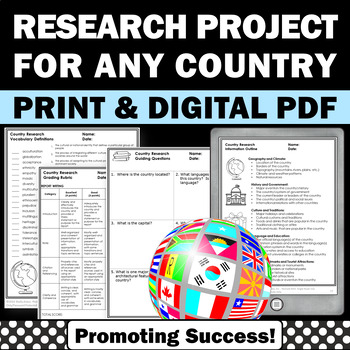Country Research Projects Study Report Countries Around the World Research
- PDF
- Easel Activity
What educators are saying
Description
Country Research Projects: This newly revised (July 2023) country study worksheet packet will help your 4th grade, 5th grade, and 6th grade social studies students conduct a country study research project for countries around the world. It not only includes country research graphic organizers and templates and for gathering information and conducting country research, but also guidance and skills for country report writing and giving a presentation. Grading rubrics, answer keys, differentiated activities, and bulletin board images are also provided.
For your convenience, this country research project comes in both TPT digital EASEL and printable PDF resource formats.
☛ Please click on the PREVIEW above.
I. Introduction
A. Explain the purpose of the country research projects
Discuss the importance of researching different countries around the world and new vocabulary
II. Selecting a Country
A. Choose a country study that interests you
Discuss with the teacher if the chosen country is suitable
III. Gathering Information
A. Look for relevant books, websites, and encyclopedias
B. Use reliable country research sources such as government websites and educational resources
C. Take notes and record sources to avoid plagiarism
IV. Topics for Country Research
A. Geography and Climate
B. History and Government
C. Culture and Traditions
D. Language and Education
E. Famous Landmarks and Tourist Attractions
V. Writing the Country Report
A. Organize notes and outline the report
B. Write an introduction, body, and conclusion
C. Use proper citation and referencing. Proofread and edit the report for clarity and coherence
VI. Creating a Presentation
A. Use visual aids such as maps, pictures, and graphs
B. Practice speaking skills and rehearse the presentation
C. Be prepared to answer questions from the audience
VII. Conclusion
A. Review what you have learned about the country
B. Reflect on the experience of researching and presenting
C. Discuss the similarities and differences between your country and other countries.
- It is best practice to give the rubric to the student prior to beginning the project.
- Differentiated options for low level learners.
- Color images for bulletin boards, posters, and more.
- Research guidelines and suggested websites now included.
Common Core Skills (may vary depending on implementation)
For gathering information:
- Reading Informational Text: RI.4.1-4.10 (Grade 4) or RI.5.1-5.10 (Grade 5), which cover skills such as determining main ideas and supporting details, making inferences, and analyzing text structure.
- Writing Research: W.4.7-4.9 (Grade 4) or W.5.7-5.9 (Grade 5), which cover skills such as gathering relevant information from multiple sources, taking notes, and citing sources properly.
For writing the report:
- Writing Opinion: W.4.1-4.2 (Grade 4) or W.5.1-5.2 (Grade 5), which cover skills such as introducing a topic, organizing ideas logically, and providing reasons and evidence to support opinions.
- Writing Informative/Explanatory: W.4.2-4.2a, W.4.2d, W.4.4, W.4.5, W.4.10 (Grade 4) or W.5.2-5.2a, W.5.2d, W.5.4, W.5.5, W.5.10 (Grade 5), which cover skills such as introducing a topic, organizing ideas logically, using precise language, and including relevant facts and details.
For presenting to the class:
- Speaking and Listening: SL.4.1-4.6 (Grade 4) or SL.5.1-5.6 (Grade 5), which cover skills such as engaging in collaborative discussions, giving oral presentations, and adapting speech to different contexts and tasks.
➥ Click HERE to go back to my storefront and browse the categories on the left.
▶︎ DIGITAL COMPATIBLE RESOURCE:
- Through the EASEL by TPT platform, you will be able to annotate and customize the PDF using overlays. Underlying content is not editable. You will then be able to assign chosen pages to your students.
▶︎ TERMS OF USE:
- Single classroom use only.
- Password protected classroom websites only, not to be found on Google search.
- No commercial use, including Outschool, etc. Contact me if you need a commercial use license.
- No reselling in any digital or print formats.
- Click HERE to see my most current terms of use.
⚙️ CUSTOMER TIPS:
- Click HERE to sign up for my newsletter with flash freebies, secret sales, and more!
- Click on the ★ above to follow my store. You will receive email notifications from TPT of newly listed products and freebies.
- Leave feedback to earn TpT credit points to save money on future products.
Thank you so much for all you are doing for kids!
❤️ Shelly Anton
Promoting Success for You and Your Students!






